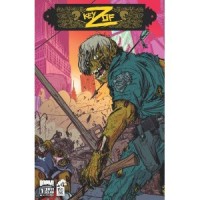Truthfully speaking, the first issue of The Key of Z, written by Coheed and Cambria's Claudio Sanchez and Chondra Echert with art by Aaron Kuder, is pretty bad. The creative team tries to capture the essence of Robert Kirkman's The Walking Dead and Brian Wood's DMZ into one dislodged concept.
While they start out by following the structure of what makes most zombie fiction great by not explaining how this cataclysmic event has occurred, the team falls short by jumping forward through time. There is no moment where a lead character is alone, afraid and confused: the moments of best drama and horror. The comic opens on Christmas Eve 2011, as lead character Nick Ewing is celebrating with his family as he witnesses the first zombie attack, a man in a Santa suit attacking a stranger on the street. Ewing bravely saves the life of an observer by striking the zombie with one of those change buckets the Salvation Army uses. The next page demonstrates how quickly society falls upon an apocalypse, uncharacteristically for the season too (it's suppose to be Christmas but there's no snow and people are wearing shorts and tank tops).
From there we get the first jump into the future of Spring 2012. Although New York City is running over with zombies, the citizens are already coming together on a massive level. We next encounter Ewing running security for a nameless politician who has secured Madison Square Garden in an attempt to reunite the five boroughs.
While in the Bronx, a gang (Lazoe Yankees) has repurposed Yankee Stadium, exchanging shelter and protection for work. Everyone has a job and pulls their weight or they face being killed or surviving on their own, outside the walls. The same has happened at Citi Field where the Mets play by a different gang.
We then jump ahead four years to the summer of 2016. Four years. There's no explanation of any major events that may have occurred. We're left with no questions to ask ourselves, other than, "Should I keep reading?" The answer being, if you spent any amount of money on this, then you've already lost and might as well finish.
Ewing, now unkempt and bearded, crosses the Brooklyn Bridge into the unknown (Manhattan?). What was great about DMZ was how it really captured New York. Always, in the top left corner of the page Wood let you know which section of the city Matty Roth was in. It was focused. Instead, unless we're familiar with the city or care (which I only did for the purpose of this review) we have to guess and look up reference pictures to be certain.
Anyways, at Yankee Lavoe, we're introduced to Eddie Alvarez, the brother of a deceased high-ranking gang member of Lavoe's company. He's being forced to go out in the city collecting essentials. Here is where the creative team shits the bed again. During the dialogue it's revealed they refer to the zombies as "sleepers." At least with Kirkman, the terms "roamers" and "lurkers" make sense. If any mythical monster should be referred to as a "sleeper" it should be a vampire or a mummy.
Soon after, the two characters meet and buddy up real quick following a weak standoff. Ewing agrees to help Alvarez with his "collecting" duties, offering up loads of weapons he emancipated from a museum collection. The following is three pages of bullshit dialogue as they travel to where it's all stored. I want to point out one page in particular that consists of four vertical panels of destruction and corpses throughout the city. The fourth panel looks awesome, as it's an image of the Brooklyn Bridge with corpses hanging from nooses over the sides.
As the comic comes to a close as the virgin Alverez misfires a weapon, attracting all the nearby "sleepers" to their presence. Ewing orders him to run as he whips out his magical harmonica, a Christmas present from his son at the beginning of the book.
And that's it. You'll have to pick up Issue 2 to find out what powers The Key of Z possesses.
To talk about the artwork a little bit. I found it pretty hit and miss. Scattered through the book are panels of silly character posing, as if Kuder knows only one way to draw a person swinging a baseball bat (full swing, front leg bent, back leg extended, torso twisted) or someone walking (both legs straight as the front leg is just touching the pavement as the back leg is leaving the ground). They really look like he copied them out of a book on how to draw. His zombies are nothing to write home about either. None are seen in extreme close up and they all have their mouths open, ready to bite, always. Kuder is at least talented when it comes to character detail. 2016 Ewing looks pretty badass like Chuck Ragan. Unlike Alverez, who looks mentally ill in half his panels.
Hopefully, in later issues the story can improve. If the team focuses more on a day-to-day basis like The Walking Dead (nine years of comics and the internal story might have just now progressed more than one year) and develop and tell New York City stories based on the differing locations and remaining culture that DMZ did so well, then I'd be happy to pick up another issue.
